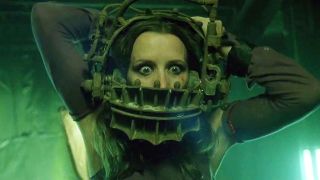You wake up in an abandoned bathroom. It’s a literal shithole: tiles once white are stained a suspicious-looking brown; broken urinals hang off the walls; flickering neon strip lights are reflected in puddles of fetid water. You wake up with no memory of how you got there. On the other side of the room another man is chained to the wall, just like you are. Then you notice it: on the floor lies a dead man. His blood seeps between the cracked floor tiles. He’s holding a gun and a tape recorder. This could be the room you die in...
Unless, of course, your name is James Wan (writer-director), Leigh Whannell (writer-actor) or Tobin Bell (he’s the ‘corpse’, playing possum). If you’re one of them, this is the room that makes you rich and famous. Fourteen years on, the Saw series has become one of the highest-grossing horror franchises in history, spawning eight sequels, games, comics and even three rollercoaster rides. How did a little movie achieve so much? We take the filmmakers back to that dank, dark bathroom to find out.

Autumn 2003: James Wan and Leigh Whannell are sitting in cattle class on a flight from Melbourne to Los Angeles. On the seat between them is ‘Billy’, a creepy-looking wood puppet handmade by Wan. He’s so precious that the wannabe filmmakers have paid for him to have his own seat rather than stow him in the hold. The cabin crew are freaked out. But this is what you do when you’re in your mid-twenties and going to Hollywood... you pull out all the stops.

The most anticipated upcoming horror movies to make you scream with excitement
“We didn’t know anybody, we weren’t at all connected,” confesses Whannell about the moment they touched down in LA. “We went into this very naïve. We couldn’t have been more naïve if we’d been born on an island and released into the world kind of like Arnold Schwarzenegger in Twins but with less muscles. We were as wide-eyed as you could possibly be.”
Wan and Whannell met at film school in Melbourne in the late-’90s. “A really arty film school with lots of black nail polish and berets and guys making films about sand,” remembers Whannell. “James would get up and show his films, and they’d be about zombies. I knew he was going to become something big.” Together they fleshed out their own low-budget horror idea. It was designed to be ultra-cheap: no huge cast, no fancy sets, just three actors locked up in one dingy room and a handful of fiendishly nasty torture sequences. Convinced they were onto something, the two friends maxed out their credit cards to shoot a 10-minute short. It featured Billy the puppet and Whannell wearing the Jigsaw killer’s ‘jaw-trap’ torture device. It was sent over to Hollywood. A few days later the boys followed it... with Billy in tow.
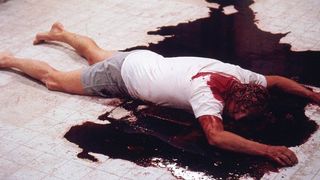
Producers Mark Burg and Oren Koules at Twisted Pictures were two of the first Americans to see the calling-card short and were blown away by its fiendish intensity. They called the boys’ agent while they were still on the flight to LA. “They landed, literally dropped their bags off and came straight over,” explains Burg. “When they walked in, Oren looked at James and said, ‘Let me get this straight – you want to direct it?’ He looked at Leigh and said, ‘And you want to star in it?’ They were like, ‘Yep.’ Oren said, ‘Well, if you can do it for a million dollars, it’s green lit. Get started.’ They both looked at each other and were like, ‘Wow, America! This is great, it’s easy!’”
The ‘ultra, ultra low-budget’ 18-day shoot itself proved arduous though. Cramped in the derelict basement bathroom that was the film’s central location, Wan was constrained not just by the walls but the tight budget and scheduling strictures. “I was really bummed by the time post-production came around,” he confesses. “I felt like I didn’t really make the film that I promised myself I was going to make and I was ultimately going to blow my opportunity as a filmmaker.”
For the three main actors, the shoot was equally gruelling as they found themselves trapped on a single cold set for 12-hour stretches. As the screenwriter, Whannell only had himself to blame. “Leigh could have written a movie like Clerks about two guys in a supermarket talking,” jokes Wan, who took great delight in torturing his friend throughout the shoot, “but instead it’s two guys in a dingy basement...”
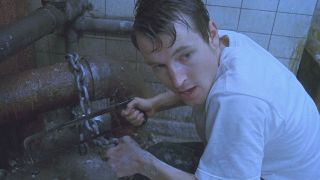
“When James is directing and I’m acting, one of his favourite ways of amusing himself is by making me uncomfortable,” explains Whannell. “For the opening scene he told me to get underwater in the bathtub and wait until he signalled me. So I’m holding my breath and all I can hear, in this muffled sort of underwater tone, is James going, ‘Let’s move that light over there a bit...’” Wan laughs and draws a comparison with another put-upon horror actor: “It’s a great thing that Leigh is such a big fan of Sam Raimi, because he really is my Bruce Campbell.” Still, in terms of suffering for one’s art no one could trump Tobin Bell.
Every horror film needs a villain but Saw’s game-playing serial killer is rarely glimpsed on-screen. He’s a phantom presence hiding behind puppets, red herrings and the film’s central corpse-that-isn’t-dead twist. “You may think there’s not a lot there for a guy lying in a pool of blood on the floor but here’s a lot of power in that,” explains Bell on the line from LA. He’s a slow, deliberate speaker and even out of character he exudes a cerebral kind of creepiness. “When I read [the final scene] it took my breath away. So, as an actor, do you read a script and say, ‘Let’s see, I have 120 lines and I’m in this scene and that scene.’ Or do you approach it from the point of view of, ‘This film is worth doing just for this scene, just for this moment; just for this touch’…”
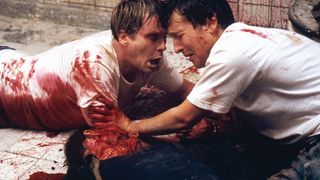
As Bell talks about John Kramer – never, not even once, calling him Jigsaw – it’s obvious where the Saw series gets its disturbing intensity. Despite looking like a potential stand-in for Vincent Price, the tall, thin actor doesn’t do camp. Just pure menace. Kramer’s no supernatural villain or beefy maniac; he’s a meticulous plotter, an intelligent man who believes he’s acting for the greater good.
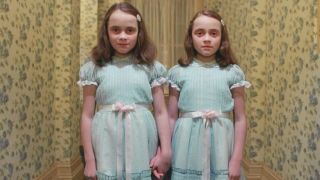
The 25 best horror movies of all time, whatever your taste in terror
“He thinks the world’s going to hell in a hand basket,” explains Bell. “It has become survival of the mediocre as opposed to survival of the fittest. As a result we have weak leaders, weak legislators, weak people in almost every walk of life. Those weaknesses are reflected in people who have everything and appreciate nothing, which disturbs him.” Jigsaw doesn’t kill people but tortures them into realising their lives are worth something.
What made Saw such a hit? In part it’s the fact that it’s a real horror movie: cheap, disreputable and seedy. Its rough-around-the-edges aesthetic only adds to the trippy, off-kilter vibe of the labyrinthine screenplay, which amongst other things includes puppets, pig masks and diabolically baroque torture scenes in which victims are trapped inside razor wire or forced to dig a key from a fellow victim’s stomach.

Se7en, the film Saw is always accused of imitating, was coy about its horror, letting the imagination of the audience plug the gaps. Saw, however, fills your reeling head with amphetamine-frenzied snuff clips, macabre off-cuts from a Nine Inch Nails video. “I think one of the things that horror fans will embrace the most is a film that’s not typical, conventional or mainstream,” reckons Wan. “The cheapness is what makes it special in the same way as the cheapness of the first Evil Dead film makes it special as well.”
Whannell agrees: “Horror fans are a strange breed; I think I’m allowed to say that because I’m one of them. You don’t wear zombie make-up and go around wearing a Hellraiser t-shirt if you’re the most popular kid at school. They’re outsiders and they really want to take ownership of something and know that it’s theirs and no one else’s. What they grabbed onto with Saw was that it was this cheap little indie film that screened at the Sundance festival and no one else knew anything about it except them. It was their little secret.”
Saw is no longer the little movie it was back in October 2004. The franchise has become a box-office juggernaut bigger than each of the Halloween, Friday and Elm Street series. Part of its success was that it pre-empted the zeitgeist. A few months before its release, reports of torture at Abu Ghraib prison made front page news in the US.
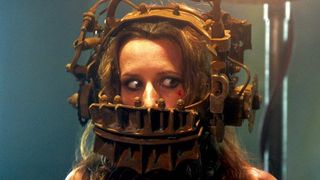
Was it a coincidence that a horror movie about a misguided torturer who believes he’s acting for the greater good proved so popular? Probably not, although no one feels particularly comfortable talking about it. “I’d like to think I was smart enough to give you an answer to that but who knows?” says Burg, deftly sidestepping the issue completely. Meanwhile, Wan is irritated by the description of the first film as ‘torture porn’ claiming it’s nothing more than “lazy journalism”.
Yet for both Wan and Whannell, the original remains forever separate from the sequels that followed. “It is a real bittersweet experience,” says Wan. “It’s so flattering that they made sequels to our movie but at the same time it feels like the sequels have given the first film the wrong perception. Now people refer to ‘the Saw films’ in a derogatory way.” Success can be both a blessing and a curse. Re-watch the original, though, and you’ll see that Saw’s edge remains dangerously sharp.
This feature original appeared in our sister publication, Total Film magazine. Subscribe here so you never miss an issue.
